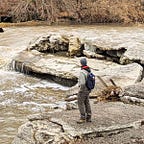Wakan Tanka, Human and the Drowning Whale
“Progress implies improvement, but man is always the same, confronting a situation that is forever changing, while choice always remains a choice in any situation.” Jean-Paul Sartre
The British Petroleum (BP) oil spill in the Gulf of Mexico in 2010 felt personal. A gut punch of profit and exploitation to natural systems which sustain life, my life included. Through my research into the event, its causes and its broader context I came across a story told by Carl Safina on a TEDxOilSpill talk about a fisherman who encountered a dolphin drowning in oil and asking for help. That story hit me right in my empathetic core, clearly stating the horror of the situation human decision making was intent on continuing to create. I ended up using that story as a jumping off point for creating “Wakan Tanka, Human and the Drowning Whale.”
The work depicted a cartoonish whale spraying oil out of its blow hole, its pupils submerged in tar. A wave, polka dotted with oil dots is crashing to the right of the whale. It is chased by a dark oil slick stretching back to a distant ash cloud raising above the waters horizon. Behind the whale, an island is split into two unequal halves by a gigantic wall with a house on its right, grey smoke coming out of the chimney, a person standing next to it. At the edge of the right side of the island a cannon that could easily fit three of the houses is firing into or at the ocean, there seems to be no other target. On the left side of the island a small tank is moving towards the wall. Clouds are drifting through the oceanscape, lit up gold from above, purple blue ocean-side. The drawing’s border is filled with fluid shapes. Bright, lively and lava-lamp-like they congress into a body in the upper right corner of the drawing. The body is in a fluid state, mixing, dripping — refining matter into more and more complex strands of DNA. It is crowned by a giant red beak and a round blue eyeball from which a light beam shoots out. The leading front of the beam is flowering with combinations of matter in an effort to purify the desecrated waters.
This creature in the corner is inspired by Wakan Tanka, great mystery, the Supreme Being and creator of the Lakota Sioux Nation, a native tribe in North America. Wakan Tanka stems from a belief that acknowledges that every creature and object is wakȟáŋ (“holy”) or having aspects that are wakȟáŋ.
The drawing was exhibited during an open studio. Later the photos of it along with the story were put together as a zine, 2 editions of 100 were printed and I distributing them randomly in central Toronto and Montreal. It wasn’t much and as far as I know it made little to no impact. But if it stopped there I probably wouldn’t bother thinking and writing about it now.
The project got me thinking about change, how we perceive it, how to influence and depict it. It is a direction that has kept me thoroughly engaged, hungry for information and challenged by finding ways of acting on the information in a worthwhile way. By embracing the child like naiveté in producing “Wakan Tanka and the Drowning Whale” I took a step toward learning to live with grief for the environment which freed me to keep engaging with, and refine my understanding of, the complexity of the issues at hand. Not being paralyzed by the information I was able to get to a place where I am thinking about how to connect what was lost to what can be protected, saved, rebuilt and what can be created.
I moved from focusing on doom to imagining a future where cities have functioning habitats, where a metric for development includes impacts on ecosystem services. I want to create work which will help people recognize the intrinsic value of natural systems so as to stop our brutal treatment of them and ourselves in the process. It is not unthinkable for our societal values to realign with those of people like the Lakota Sioux Nation. Just a week ago, the idea of stopping the world’s air travel along with so many other things seemed impossible and yet motivated and humbled by a pandemic we chose to pause. In that pause I hope that we can recognize just how much power our choices make and consider what future we will chose to create once we hit play again.
